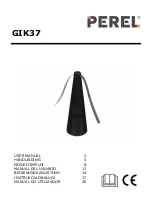
4
®
5. TECHNICAL DATA
Fuel: two standard versions for Natural Gas (NG) and for Propane Gas or LPG (PG) - see gas characteristics in
Appendix 1. In case of other fuel gas needed
see p. 11 Ordering Information Special Pilots and Appendix 3.
Outer diameter of the air tube:
48.0 mm
Outer diameter of the mounting tube: 55.0 mm
Outer diameter of the ignition rod: ≤16.0 mm
Capacity range :
Natural Gas 63 ÷ 132 kW - see capacity vs. pressure graph in Appendix 1
Propane Gas
98 ÷ 203 kW - see capacity vs. pressure graph in Appendix 1
- in case of other capacity range needed -
see p. 11 for Special Pilots
Air flow and pressure: max. ~ 30 m3/h – adjust to capacity as in p. 8.11
Air pressure range 0.5-1.0 (max. 1.2 kPa)
Air connection
3/4" BSP (inner thread)
Gas connection
1/2" BSP (inner thread)
Operating temperature
max. continuous 300°C, swirler-stabilizer, end of gas and air tubes 500°C
Igniter rod
reference length range “L”
0.5 ÷ 3.0 m
- longer upon request
Pilot weight: P/N
SP-48-
NG/PG
-FD-0.5
(length L=0.5 m): 2.96 kg, pilot weight adder: approx. 2,60 kg/m
Material used for pilot construction all parts: 304/316 SS and heat-resistant steel 310/330
Notes
:
1. If the above parameters are different than those required please contact Fireye
2
. For Imperial Units please refer to the Appendix 4 Unit Conversion Table
3
. Device
complies with the requirements of the European Directive 2002/95/EC (RoHS)
6. OPERATIONAL SAFETY
When operating and handling the pilot burner please follow the rules below:
6.1 Use pilot only for its intended purpose.
6.2 At the time of installation, operation and maintenance follow the procedures described in the instructions
and documentation of the pilot, ignition device and the main burner.
6.3
Check environmental conditions and ensure that the specified operating temperatures of pilot and
igniter components will not be exceeded
(
see p. 5 and igniter Manual).
6.4 Follow the warnings contained in the documentation.
6.5 Do not make any modifications or changes to the pilot construction.
6.6 Before starting, make sure that all parts of the pilot and electric ignition device are in good condition.
6.7 Circuits of power packs as well as igniter rods, enclosures and junction boxes must be properly grounded.
6.8 Before igniting, check the tightness of gas tube connections.
6.9 During the observation of the pilot flame wear special goggles to protect the eyes from flame UV radiation.
6.10 Do not remove the protective ground when the ignition device is energized.
6.11 Before working on the ignition device, ensure the power is disconnected.
6.12 Before maintenance or repair works check that the gas shut-off valve is closed.
6.13 During installation, start-up or maintenance works on the pilot or burner/ heater always wear protective
clothing and use protective gloves.
WARNING
: ALL ACTIONS RELATED TO THE INSTALLATION, SERVICE AND
OPERATION OF GAS PILOT MAY ONLY BE CARRIED OUT BY A TRAINED AND
QUALIFIED PERSONNEL.
REMARK
: IN CASE OF ANY DOUBTS REGARDING INSTALLATION OF THE PILOT
CONSULT WITH THE MANUFACTURER.

































